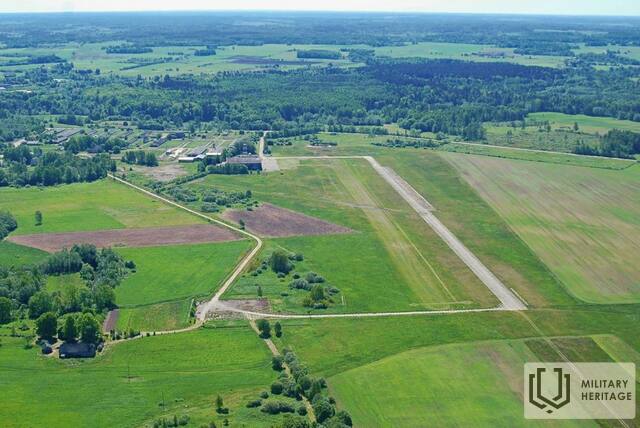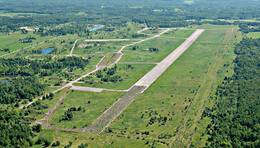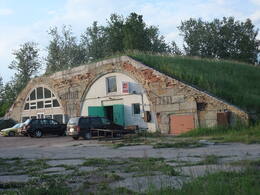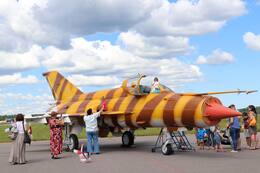Cīravos aerodromo istorija
Cīravas aerodromas – įkurtas Antrojo pasaulinio karo metais, sovietų naudotas kaip DOSAAF aerodromas, šiuo metu naudojamas žemės ūkio reikmėms ir pramoginėms kelionėms, angare galima apžiūrėti sovietmečio lėktuvus.
Cīravas oro uostas (ICAO: EVIA) – nesertifikuotas aerodromas Cīravo valsčiuje, Aizputės savivaldybėje. Pastatytas ant Durbės upės kranto, 2 km nuo Cīravos kaimo centro. Oro uoste yra du kilimo ir tūpimo takai: 800 m ilgio ir 20 m pločio betoninis kilimo ir tūpimo takas bei lygiagretus 800 m ilgio žolės kilimo ir tūpimo takas. Pagal bazių sutarties sąlygas 1939 m. sovietų karių kontingentas Ciravoje pradėjo statyti karinį aerodromą. Antrojo pasaulinio karo metais aerodromas buvo naudojamas iki 1945 m. balandžio 4-5 d. gegužės mėn. naudojo Vokietijos liuftvafė.
Pasibaigus karui jis buvo naudojamas kaip DOSAAF aerodromas, kuriame veikė Jurijaus Gagarino vardu pavadintas Kuržemės aviacijos klubas, kurio veikla daugiausia buvo susijusi su sklandymu.
Šiuo metu aerodromą naudoja „Kurzemes Avioklubs“ pramoginiams skrydžiams su motoriniais sklandytuvais ir parašiutinėms pamokoms.
https://lv.wikipedia.org/wiki/C%C4%ABravas_lidlauks
Kurzemes Avioklubs – aerodromas, lėktuvai, sklandytuvai, skrydžiai, aviacijos šou, aviacija (airclub.lv)
Susijusi laiko juosta
Susijusios temos
Susijusios vietos
Vainodės oro bazė
Vainodės aerodrome vis dar yra 16 sovietmečio orlaivių angarų ir 1800 m ilgio kadaise 2500 m ilgio tako atkarpa. Aerodromą galima aplankyti tik iš anksto užsiregistravus. Vainodės aerodromas buvo įkurtas Latvijos nepriklausomybės metais kaip vienas iš Latvijos aviacijos lopšių, o vėliau tapo vienu didžiausių karinių aerodromų Baltijos šalyse. 1916 m. buvo pastatyti du angarai Vokietijos armijos dirižabliams. Dirižabliai buvo naudojami žvalgybai rinkti ir Rusijos armijos pozicijoms bombarduoti. Vėliau Rygos miestas įsigijo dirižablių angarus ir panaudojo jų stogo konstrukcijas Rygos centrinio turgaus paviljonams pastatyti. 1940 m. gegužę į Vainodę persikėlė 31-asis Raudonosios armijos greitųjų bombonešių aviacijos pulkas ir pradėta standartizuoto betoninių plokščių tako statyba. 1944 m. vasaros pabaigoje nebaigtu aerodromu naudojosi įvairūs vokiečių aviacijos daliniai, tačiau Antrojo pasaulinio karo pabaigoje tą patį aerodromą naudojo Raudonosios armijos aviacijos daliniai, kovoję su vokiečių armijos grupuote „Kurzeme“. Po Antrojo pasaulinio karo Sovietų Sąjungos oro pajėgos Vainiodėje buvo dislokuotos iki 1992 m.
Rumbulos oro bazė
Įsikūręs Rygos pietryčiuose, Rumbuloje, tarp Maskavas gatvės ir Dauguvos upės.
Rumbuloje buvo Sovietų armijos karinių oro pajėgų bazė ir civilinis oro uostas šalia pagrindinio Rygos oro uosto Spilvėje. Abu oro uostai egzistavo iki Rygos oro uosto atidarymo. Prieš Antrąjį pasaulinį karą ir Latvijos okupaciją Rumbuloje buvo Latvijos armijos aviacijos pulko aerodromas.
Po Antrojo pasaulinio karo Sovietų Sąjunga pradėjo gaminti reaktyvinius orlaivius, kuriems reikėjo ilgesnių ir lygesnių kilimo ir tūpimo takų. Seni aerodromai buvo plečiami ir statomi nauji. Besikeičiančios oro sąlygos Baltijos šalyse ir trumpas pirmųjų reaktyvinių lėktuvų skrydžio laikas buvo daugelio atsarginių aerodromų sukūrimo priežastis. Reaktyvinių lėktuvų triukšmas sukėlė Rygos gyventojų nepasitenkinimą, nes karinis aerodromas buvo per arti gyvenamųjų rajonų ir galėjo sukelti pavojingas situacijas. 1973 m. jis buvo uždarytas, o jo vietoje pastatytas Lielvārdės aerodromas, į kurį buvo perkelti koviniai lėktuvai. Netrukus prieš uždarymą kilo tarptautinis skandalas. Ten buvo sumuštas JAV oro pajėgų karininkas, kuris buvo vienas iš karinių atašė Maskvoje. Įtariama, kad jį užpuolė 14–20 oro uosto darbuotojų, įtarusių, kad aerodromas yra fotografuojamas.
Šiandien galite aplankyti apleistą aerodromo teritoriją.
Pagalvės oro uostas
Įsikūręs Rygoje, Pārdaugavoje, Spilvės pievose netoli Iļģuciems.
Spilvė karinio paveldo istorijoje garsėja ambicingu Spilvės mūšiu XVIII a. ir Spilvės aerodromas. Nuo XX amžiaus jis buvo naudojamas orlaivių bandymams, o Pirmojo pasaulinio karo metais tapo Latvijos aviacijos istorijos liudininku.
Pirmojo pasaulinio karo metais Spilvės pievas naudojo Rusijos kariuomenės oro pajėgos kovoje su vokiečių kariuomene. Sukūrus Latviją, aerodromas tapo svarbiausia šalies oro pajėgų baze ir pilotų poligonu. Ankstesni oro uosto pavadinimai buvo „Spilvės oro uostas“ arba „Rygos oro uostas“, vėliau „Rygos centrinis oro uostas“. Tai buvo pagrindinis oro uostas Latvijoje iki Rygos oro uosto atidarymo 1975 m.
Galbūt prie įspūdingų ne vieno Latvijos piloto pasiekimų prisidėjo prie Rygos esantis Spilvės aerodromas ir svajonė pasiekti žvaigždes. Galbūt, tačiau Latvijos aviacijos užuomazga gerokai senesnė ir ją galima rasti Priekulėje, kur latvių kalvis Zviedris savadarbiu aparatu išskrido iš bažnyčios bokšto.
Šiandien Spilvės oro uostas veikia. Galima pamatyti 1954 metais pastatytą oro uosto pastatą, kuris įkūnija sovietinį klasicizmą arba „Stalino imperijos“ stilių.
Šaltiniai:
Irbītis, K. Latvijos aviacija ir jos pradininkai. Ryga: Mokslas, 2004.
Brūvelis, E. Latvijos aviacijos istorija: 1919-1940. Ryga: Mokslas, 2003.
Oficiali valstybinės agentūros „Civilinės aviacijos agentūra“ svetainė. Prieiga: https://www.caa.gov.lv/lv/latvijas-aviacijas-vesture-isuma [žiūrėta 2021 02 22].
Aviacijos muziejus „SKY ZOO“
Aviacijos muziejus „Sky Zoo“ yra Smārdės valsčiuje, Tukumo savivaldybėje, Jūrmalos oro uosto teritorijoje, kuri anksčiau buvo Tukumo karinis aerodromas. Ekspozicijoje eksponuojami lėktuvai YAK-40, AN-2, SU22M4, PZL TS-11 Iskra ir sraigtasparnis MI-24. Ekskursijos po aerodromą metu apžiūrimi angarai, kaponieriai ir inžinerinė įranga. Aerodromą naudojo tiek Vokietijos, tiek Sovietų Sąjungos armijos. Sovietų okupacijos metu tai buvo vienas svarbiausių karinių aerodromų Latvijos teritorijoje. Jame dislokuoti naikintuvai buvo skirti atakuoti priešo laivus ir bombarduoti pakrantės įtvirtinimus. 1975 m. lapkričio 9 d. naktį Tukumo aerodrome buvo gautas kovos signalas – Sovietų Sąjungos teritoriniuose vandenyse (Rygos įlankoje) buvo priešo karo laivas, kurį reikėjo sunaikinti. Iš Tukumo pakilo keli lėktuvai. Tačiau paaiškėjo, kad ginkluotas maištas prieš esamą sovietų režimą įvyko sovietų karinio jūrų laivyno karo laive „Storoževoi“ („Globėjas“). Lėktuvams pasiekus karo laivą, mūšis dar tęsėsi. Vėliau sukilėlių vadas Valerijus Sablinas, sovietų karinio jūrų laivyno karininkas, buvo sužeistas, o maištas baigėsi. Jam buvo skirta mirties bausmė už išdavystę. Tai buvo vienas dramatiškiausių įvykių, rodančių nepasitenkinimą režimu ir žyminčių artėjantį jo žlugimą.










